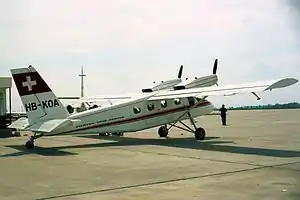Pilatus PC-8D Twin Porter
The Pilatus PC-8D Twin Porter was a Swiss ten-seat light transport built by Pilatus Aircraft. The type did not go into production and only one was built.[1]
| PC-8D Twin Porter | |
|---|---|
 | |
| Role | STOL Light transport |
| National origin | Switzerland |
| Manufacturer | Pilatus Aircraft |
| First flight | 28 November 1967 |
| Status | Scrapped |
| Number built | 1 |
| Developed from | Pilatus PC-6 |
Work on the Twin Porter started in 1966, it was a modified Pilatus PC-6 high-wing monoplane with the nose-mounted engine removed and two 290 hp Lycoming IO-540-GIB engines mounted on the wing leading edges.[2] The prototype first flew on 28 November 1967.[3] Only one aircraft was built as flight testing was halted in 1969.
Development
To keep development costs down, as many components as possible were adopted from the single-engine PC-6 Porter, such as the center fuselage, the wings and main landing gear. There was a new development of the forward fuselage, also with the tail and the arrangement of the propellers. The cabin was easily converted for various tasks. First drafts showed a motor assembly right and left of the fuselage nose, similar to the Dornier Do 28. A tandem arrangement of the engines like on the Dornier Wal above the fuselage, as with the earlier flying boats, was considered. In the final design, the engines were located very close, in front of the wings, to the fuselage with separate engine pylons. There was no fixed connection between the engines and the wings, but a gap as in a slat. With this arrangement, it was hoped to obtain favorable values for single-engined flight.
Flight testing
On 28 November 1967, the PC-8D prototype made its first flight. The results from more than a year of flight testing were not satisfactory, so they abandoned the project at the end of January 1969. Because of the lack of single-engine performance, approval by FAR23 was not possible. The PC-8D Twin Porter was presented also at the international air show in Paris. The only aircraft built was scrapped after the project.
Simultaneously, Pilatus began the development of the training aircraft PC-7 powered by a turboprop engine. This made it possible to retrofit existing piston-engined Pilatus Porters with turboprop engines, with minimal changes to the airframe. The desired higher power of the twin PC-8D was achieved with lower operating and maintenance costs. A PC-8 with twin turboprop engines was considered, but was abandoned due to lack of market demand.
Specifications
Data from Jane's All the World's Aircraft 1968–69[4]
General characteristics
- Crew: one
- Capacity: nine passengers
- Length: 10.50 m (34 ft 5 in)
- Wingspan: 15.60 m (51 ft 2 in)
- Height: 3.65 m (12 ft 0 in)
- Wing area: 32.4 m2 (349 sq ft)
- Empty weight: 1,550 kg (3,417 lb) (equipped)
- Max takeoff weight: 2,700 kg (5,952 lb)
- Powerplant: 2 × Lycoming IO-540-GIB5 air-cooled six-cylinder horizontally-opposed, 220 kW (290 hp) each
- Propellers: 3-bladed Hartzell HC-A3VK/V8433-4, 2.03 m (6 ft 8 in) diameter
Performance
- Maximum speed: 260 km/h (160 mph, 140 kn)
- Cruise speed: 230 km/h (140 mph, 120 kn) max cruise (70% power at sea level)
- Range: 1,400 km (870 mi, 760 nmi) max fuel, 620 kg (1,370 lb) payload, no reserves
- Rate of climb: 6 m/s (1,200 ft/min)
- Take off distance to 15 m (50 ft): 260 m (850 ft)
- Landing distance from 15 m (50 ft): 250 m (820 ft)
See also
| External images | |
|---|---|
| Pilatus PC-8 Twinporter | |
Related development
Aircraft of comparable role, configuration, and era
References
| Wikimedia Commons has media related to Pilatus PC-8. |
- Pilatus Aircraft Ltd – Chronicle, retrieved 12 January 2013
- Harrison, Neil (23 November 1967). "Commercial Aircraft Survey". Flight International. p. 869. Retrieved 12 January 2013.
- "World News: Twin Porter Revealed". Flight International. 28 March 1968. p. 434. Retrieved 12 January 2013.
- Taylor 1968, p. 151
- Taylor, John W. R. (1968). Jane's All the World's Aircraft 1968–69. London: Sampson Low, Marston & Company, Ltd.CS1 maint: ref=harv (link)